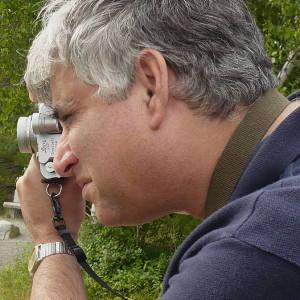Hex River Pass. Leitz Elmar 50mm
Today is dismal and depressing weather-wise. We're almost halfway through April and the temperature is hovering just above freezing, there is freezing rain and they're promising sleet tonight. I went for a hopeful spin along the river but even the birds are depressed and kept themselves hidden. So here I go back to the Blip Police-defying archives... This is a scan from what looks to be a rather over-exposed print from August 1978.
I was on the Trans Karoo Express traveling to meet my brother and mom at Matjiesfontein. They drove the 180 miles from Cape Town by car. I wanted the adventure of ascending the magnificent Hex River Pass by train. See here for more about the Trans Karoo.
Here's some history: When diamonds were discovered at Kimberley in 1867 there was suddenly a pressing need for a railway line linking Cape Town with the diggings situated on South Africa's high inland plateau called the Karoo. The line set off boldly from Cape Town using the British railway gauge of 4ft, 8-1/2 inches. When it reached the town of Worcester at the foot of the mountains, the problems started.
The line had to rise about 2300 feet in less than 30 miles. Unlike railways in Europe, this was a project done on the cheap: single track, follow every fold of the land, no tunneling, no bridgework. A potential alignment was surveyed which had one short tunnel, a ruling gradient of 1 in 40 and very sharp curves. To get the railway around the tight curves, the gauge was reduced to 3 foot 6 inches. This was it's first use ever and became know as "Cape Gauge". The line opened in about 1877. Until it was electrified in 1954, the motive power was a variety of steam locomotives specially designed to deal with gradients and sharp curves. North bound trains were "banked" by an extra locomotive at the back of the train not only to provide additional motive power but also to prevent a disaster if the brakes failed on the pass. All that went away with electrification. The immensely powerful locomotives, one or sometimes two per train ascended the gradients with no muss or fuss. They were so sophisticated for the time that on the descent, the electric motors acted as generators, producing a braking effect as well as feeding the current produced by the effect of gravity back into the electric grid. How clever is that?!
I was fairly near to the back of the 17-coach train and this provided a nice vantage point to show how the line does in fact follow every curve of the mountain while ascending continuously on that 1 in 40 gradient.
It's all gone now: the Hex River Pass, a lonely and mysterious place has been replaced by a series of very long tunnels, amongst the longest in the world, which cut right under the mountain, bypassing the summit at Matroosberg station, and reach the Karoo at Kleinstraat. I'll add a link to Charlie Lewis' fabulous history of the pass in Soul of a Railway.

Comments
Sign in or get an account to comment.


